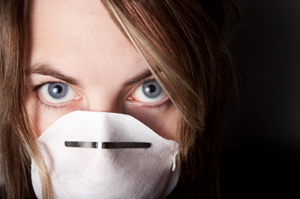Until 1936, pneumonia was the number one cause of death in the United States, but the advent of antibiotics was able to decrease its effects so that now pneumonia ranks sixth on that list. Before medical advances, one in three with pneumonia died. Still, over three million people annually come down with pneumonia in this country, with half a million hospitalized and five percent of those succumbing to it. Pneumonia is caused by bacteria, viruses, fungi, and parasites and it infects one or both lungs and comes with a variety of symptoms. And contrary to what mom might tell you, being out in the cold without your coat or playing in the rain won’t give you pneumonia.
There are many kinds of pneumonia, with many kinds of causes. The micro-organisms that precipitate pneumonia include viruses such as rhinovirus, influenza virus, and parainfluenza virus. Bacteria, fungi, and parasites are also responsible for pneumonia. Germs normally present in the mouth, nose, and throat sometimes can make their way into the lungs, especially when people are asleep. They aspirate secretions from these sources into their lungs; under normal circumstances they cough them up or their immune system dispatches them. However, when they are in a weakened state from other illnesses or recent maladies, they can be susceptible to pneumonia developing. Those most at risk of coming down with pneumonia are those with recent viral infections, lung disease, swallowing difficulties, heart disease, alcoholics, drug abusers, and people who have had strokes.
Once organisms invade the lungs, which can also occur when people breathe in droplets that containing the germs that cause the illness that have become airborne from coughing and sneezing by those infected with them, they settle in the air sacs and multiply. The body attempts to fight them off, and the lungs can fill with fluid and pus. Bacterial pneumonia is often caused by Sterptococcus pneumoniae, and comes on rapidly with symptoms such as the chills and fever. This infection can spread into the blood a quarter of the time, with a quarter of these patients dying. There is a vaccine available for this bacteria, and penicillin, amoxicillin, and erythromycin are a few of the antibiotics used to battle bacterial pneumonia. Hemophilus pneumonia is a form that infects people suffering from chronic pulmonary obstructive disease or alcoholism, and the slowly developing mycoplasma pneumonia can strike in the summer and autumn months, rather than the usual flu season of winter. Legionnaire’s disease is a type of affliction that lists pneumonia as a symptom, with contaminated water supplies and the water in air conditioners supplying the infecting bacteria.
Viral pneumonia normally cannot be treated with antibiotics, and must be allowed to be fought off by the body’s immune system. Fungal infections are responsible for a small percentage of pneumonia cases. The general symptoms of pneumonia are fever, chills, coughing, rapid breathing, labored breathing, vomiting, chest pains, fatigue, and loss of appetite. Coarse breathing with crackling sounds from the lungs will make your doctor suspect pneumonia, and a chest X-ray can confirm this. Sputum samples can help them to detect if the pneumonia is bacterial, and blood tests can help differentiate between viral and bacterial pneumonia. A bronchoscopy gives your physician a better view of the lungs and can collect samples from infected parts of the lungs. Fluid can collect in large volumes in the lungs during pneumonia, and can be removed with a large needle inserted into the chest cavity.
Viral pneumonia comes with the risk of a secondary infection that can bring bacterial pneumonia, and is treated with antibiotics. People who have had surgery and are confined to bed are at risk of developing pneumonia, as their lungs do not get the chance to fully aerate. If you are treated at home for pneumonia, you will be given medications depending on the type and will be told to keep hydrated. Over-the-counter products can be used to fight the symptoms, and plenty of rest will be necessary to recover. The elderly should get a flu shot to reduce the chances of influenza pneumonia, and anyone recovering from pneumonia should get a follow-up X-ray to confirm that the pneumonia is fully out of their system. They must also take the full course of prescribed antibiotics to insure the pneumonia doesn’t creep back into the picture.
A form of pneumonia called hospital-acquired pneumonia comes during or after hospitalization for another aliment. The micro-organisms that one is exposed to in a hospital are much different from those of their everyday environment, and since the person is almost always already in a weakened state from some other malady, they contract this type of pneumonia, which is deadlier than other strains. This is why pneumonia that people come down with during hospital stays is so dreaded. Pneumonia can kill you when it affects the lungs so badly that you cannot successfully breathe well enough to stay alive. The lungs or the area surrounding them can fill with fluid and then become stiff, making it nearly impossible to transfer enough oxygen to the bloodstream. Sepsis and septic shock can also cause death, most often in bacterial pneumonia cases. As far as medicine has come in seven decades, pneumonia still has the ability to take over sixty thousand lives in this nation each and every year.




